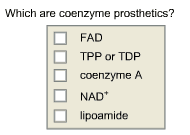BCH210H1 Lecture Notes - Lecture 10: Oxaloacetic Acid, Flavin Mononucleotide, Porphyrin

49
BCH210H1 Full Course Notes
Verified Note
49 documents
Document Summary
Cofactors required to convert inactive enzymes (apoenzymes) to active (holoenzymes) Cofactors include: essential ions (metal, organic compounds coenzymes. Activator ions reversibly bound and often participate in binding substrates. Metal ions of metalloenzymes some cations are tightly bound and participate directly in catalytic reactions. Cosubstrates specific for chemical groups that accept and donate: hydrogen or electron. Prosthetic groups large groups covalently attached at reactive centre: can be derived from vitamins. > 25% known enzymes require metallic cations for full catalytic function: metal-activated enzymes have an absolute requirement for added metal ions or alternatively are stimulated by addition of metal ions. Monovalent cations/divalent cations (e. g. k+, ca2+, mg2+) Usually transition metals: iron and zinc, and sometimes copper and cobalt. E. g. cofactor for carbonic anhydrase (reaction of water and carbon dioxide end product of aerobic respiration) is an electrophilic zn2+ atom bound to the side chains of 3 histidine (imidazole rings) residues and a molecule of water.


